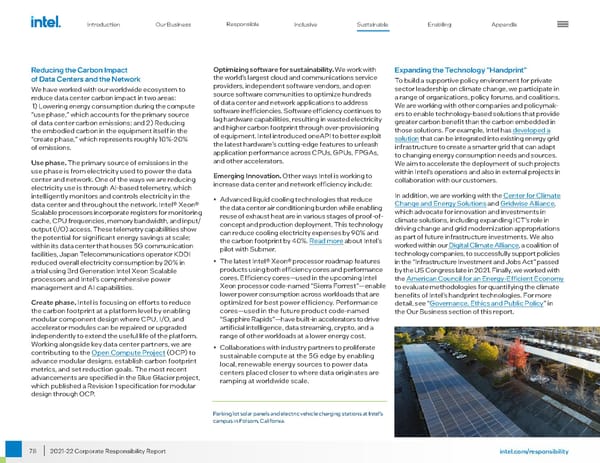78 intel.com/responsibility 2021-22 Corporate Responsibility Report Reducing the Carbon Impact of Data Centers and the Network We have worked with our worldwide ecosystem to reduce data center carbon impact in two areas: 1) Lowering energy consumption during the compute “use phase,” which accounts for the primary source of data center carbon emissions; and 2) Reducing the embodied carbon in the equipment itself in the “create phase,” which represents roughly 10%-20% of emissions. Use phase. The primary source of emissions in the use phase is from electricity used to power the data center and network. One of the ways we are reducing electricity use is through AI-based telemetry, which intelligently monitors and controls electricity in the data center and throughout the network. Intel® Xeon® Scalable processors incorporate registers for monitoring cache, CPU frequencies, memory bandwidth, and input/ output (I/O) access. These telemetry capabilities show the potential for significant energy savings at scale; within its data center that houses 5G communication facilities, Japan Telecommunications operator KDDI reduced overall electricity consumption by 20% in a trial using 3rd Generation Intel Xeon Scalable processors and Intel’s comprehensive power management and AI capabilities. Create phase. Intel is focusing on efforts to reduce the carbon footprint at a platform level by enabling modular component design where CPU, I/O, and accelerator modules can be repaired or upgraded independently to extend the useful life of the platform. Working alongside key data center partners, we are contributing to the Open Compute Project (OCP) to advance modular designs, establish carbon footprint metrics, and set reduction goals. The most recent advancements are specified in the Blue Glacier project, which published a Revision 1 specification for modular design through OCP. Optimizing software for sustainability. We work with the world’s largest cloud and communications service providers, independent software vendors, and open source software communities to optimize hundreds of data center and network applications to address software inefficiencies. Software efficiency continues to lag hardware capabilities, resulting in wasted electricity and higher carbon footprint through over-provisioning of equipment. Intel introduced oneAPI to better exploit the latest hardware’s cutting-edge features to unleash application performance across CPUs, GPUs, FPGAs, and other accelerators. Emerging Innovation. Other ways Intel is working to increase data center and network efficiency include: • Advanced liquid cooling technologies that reduce the data center air conditioning burden while enabling reuse of exhaust heat are in various stages of proof-of- concept and production deployment. This technology can reduce cooling electricity expenses by 90% and the carbon footprint by 40%. Read more about Intel’s pilot with Submer. • The latest Intel® Xeon® processor roadmap features products using both efficiency cores and performance cores. Efficiency cores—used in the upcoming Intel Xeon processor code-named “Sierra Forrest”—enable lower power consumption across workloads that are optimized for best power efficiency. Performance cores—used in the future product code-named “Sapphire Rapids”—have built-in accelerators to drive artificial intelligence, data streaming, crypto, and a range of other workloads at a lower energy cost. • Collaborations with industry partners to proliferate sustainable compute at the 5G edge by enabling local, renewable energy sources to power data centers placed closer to where data originates are ramping at worldwide scale. Expanding the Technology "Handprint" To build a supportive policy environment for private sector leadership on climate change, we participate in a range of organizations, policy forums, and coalitions. We are working with other companies and policymak - ers to enable technology-based solutions that provide greater carbon benefit than the carbon embedded in those solutions. For example, Intel has developed a solution that can be integrated into existing energy grid infrastructure to create a smarter grid that can adapt to changing energy consumption needs and sources. We aim to accelerate the deployment of such projects within Intel’s operations and also in external projects in collaboration with our customers. In addition, we are working with the Center for Climate Change and Energy Solutions and Gridwise Alliance , which advocate for innovation and investments in climate solutions, including expanding ICT’s role in driving change and grid modernization appropriations as part of future infrastructure investments. We also worked within our Digital Climate Alliance , a coalition of technology companies, to successfully support policies in the “Infrastructure Investment and Jobs Act” passed by the US Congress late in 2021. Finally, we worked with the American Council for an Energy-Efficient Economy to evaluate methodologies for quantifying the climate benefits of Intel’s handprint technologies. For more detail, see “ Governance, Ethics and Public Policy ” in the Our Business section of this report. Parking lot solar panels and electric vehicle charging stations at Intel’s campus in Folsom, California. Introduction Our Business Responsible Inclusive Sustainable Enabling Appendix
 Intel Corporate Responsibility Report Page 77 Page 79
Intel Corporate Responsibility Report Page 77 Page 79